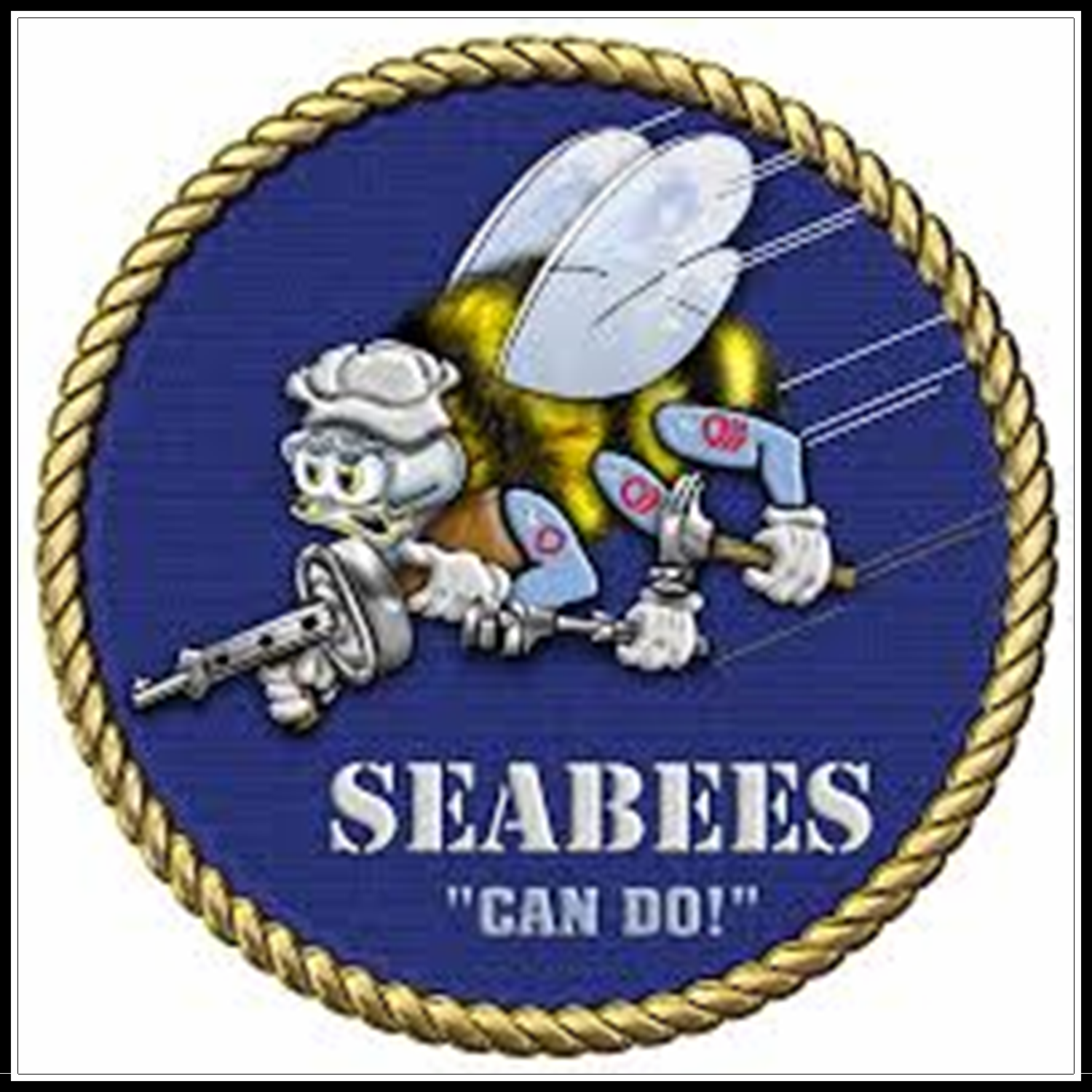
US Navy SeaBees

Courtesy Wikipedia
When World War II broke out the Seabees did not exist. The vast oceans between the United States and the enemy in both theaters made thelogistics of war a prime concern. Admiral Moreell completely understood the issues at hand and decided that he knew what needed to be done, build staging bases and Naval Construction Battalions to do build them were the answer. The concept of Naval Construction Battalions had been slowly developing atBuDocks in the 1930s. The onset of war clarified to Admiral Moreell the need to be able to develop advance bases to project American power. The solution was to tap the United States vast pool of skilled labor and put it in uniform to build anything, anywhere under any conditions and get the Marine Corps to train them. "The first volunteers were not unskilled recruits at enlistment. Emphasis was placed on experience and trade skill, so all they had to do was adapt to military life and perform the trade they knew. To obtain men with these qualifications military age standards were modified. For Seabees the enlistment age range was 18–50 however, it was later found that several men past 60 had managed to enlist. Men were given advanced rank/pay based upon experience making the Seabees the highest paid group in the U.S. Military. In the first 60 battalions the average age was 37. After December 1942 voluntary enlistments were halted by orders of PresidentRoosevelt, after which men for the CBs had to be obtained through the Selective Service System. Seabee recruits were then younger and came into the service with only rudimentary skills. To address this issue the Seabees created training programs in every trade they needed. "The first recruits were the men who had built Boulder Dam, the national highways, and New York's skyscrapers. They had worked in the mines and quarries, dug the subway tunnels, worked in shipyards and built docks and wharfs. They knew more than 60 skilled trades, not to mention the unofficial ones of souvenir making, the art of cumshaw, and "moonlight procurement". Nearly 11,400 officers joined the Civil Engineer Corps during the war, and 7,960 of them served with the Seabees. While Seabees got their name from Construction Battalions, the primary unit of the Naval Construction Force NCF, there were many Seabees that served outside the NCF. When he was done Admiral Moreell created a construction juggernaut, simultaneously constructing on multitudes of islands across vast distances, that took American forces to victory on roads and bases it had built. The Seabees were so quick that their Acorn assignments were often seen as tactical operations with them working under fire. The need for a militarized Naval Construction Force to build advance bases in the war zone became evident on December 7th. On 28 December 1941, Admiral Moreell requested authority to created Naval Construction Battalions, and on 5 January 1942, he gained authority from the Bureau of Navigation to recruit skilled construction tradesmen. The average age for the men being enlisted was 37 during the first year. Naval Construction Battalions were officially authorized on 5 March 1942. The first three Battalions iuiwere formed that month by the Admiral. Enlistment was voluntary until December 1942, when theSelective Service System became responsible for recruitment. After basic training newly formed battalions were sent to either Advanced Base Depot at Davisville, Rhode Island, or ABD Port Hueneme, California , for advanced combat/technical training before shipping out. Between tours units be would returned to the Recuperation and Replacement Center at Camp Parks, California. A pressing issue for the Bureau of Yards and Docks(BUDOCKS) was who should command the construction battalions? Navy regulations stated that command of naval personnel was limited to line officers of the fleet. Yet, it was deemed essential that Construction Battalions be commanded by Civil Engineer Corps officers trained in the skills required for the execution of construction projects which was what BUDOCKS proposed. However, the Bureau of Naval Personnel strongly objected to this violation of Naval tradition. Circumventing this opposition, Admiral Moreell took the issue to the Secretary of the Navy himself. On 19 March 1942 the Secretary gave the CEC authority to command all officers and enlisted assigned to naval construction units greatly simplifying NCF administration and operations. Equally important was the significant esteem it gave the Civil Engineer Corps by elevating the CEC to lawful command status for combat operations. With Construction Battalions authorized and the question of command settled, BuDocks then had to confront the issues of recruiting, enlisting, and training. Following that was organizing the battalions into units and logistically supporting their operations. Plans were quickly developed to do all this. Due to the exigencies of war there was a great deal of improvisation used to get it done, which came to be a synonymous with the Seabees in general. At Naval Construction Training Centers and Advanced Base Depots on both coasts, Seabees learned construction trades, military discipline as well as advanced combat training. Although technically support troops, Seabees frequently found themselves in under fire with the Marines. After completing boot training atCamp Allen VA and later Camp Peary VA, the Seabees were formed into construction battalions or other smaller CB units. The first four battalions were deployed immediately upon completion of boot training due to a pressing backlog of construction projects. Battalions that followed were sent to an Advanced Base Depot at eitherDavisville, Rhode Island, or Port Hueneme, California . There CBs or CB units were staged, outfitted receiving six weeks of advanced military and technical training before receiving work orders and shipping out. Basic military training was done by the Navy while theMarine Corps instructed Seabees in advanced military training at Camp Peary, Camp Lejeune or Camp Pendelton. About 175,000 Seabees were staged directly through Port Hueneme during the war. "As the war wore on, long deployed Pacific theater CBs and CB units were returned to the Construction Battalion R&R Center at Camp Parks, Shoemaker, California. There units were reorganized, re-deployed or decommissioned. Men were given 30-day leaves and later, eligible men were discharged at Camp Parks. The same was done at the Advance Base Receiving Barracks at Davisville, Rhode Island, for Atlantic battalions." The fundamental unit of the Seabee organization was the Construction Battalion comprised of a headquarters company and four construction companies. Each company could do smaller jobs independently as they had tradesmen with the necessary skills for doing any job. Headquarters was be staffed by yeoman, storekeepers, medical and dental personal, draftsmen, surveyors, cooks, laundrymen, post office, gunners-mates andshore patrol. The standard battalion complement was set at 32 officers and 1,073 enlisted. "In 1944–45 construction projects became larger and more complex, more than one battalion frequently had to be assigned to a job. For efficient administrative control, battalions were organized into a regiment, and when necessary, two or more regiments were organized into a brigade. If needed two or more brigades would be organized into a naval construction force. An example was what happened on Okinawa. There, 55,000 Seabees were deployed with the battalions organized into regiments and brigades. All were under the command of the Commander, Construction Troops, Commodore Andrew G. Bisset (CEC). In addition to the Seabees his command also included 45,000 U. S. Army engineers, plus a few British engineers. In total the Admiral commanded 100,000 construction troops, the largest concentration of construction troops ever." Very little time passed before the Bureau of Yards and Docks realized the need for special-purpose units. While the Construction Battalion itself was versatile enough to handle any project, it was apparent that some units could be specialized or smaller. "The first departure from the standard CB was the "Special" Construction Battalion, or as it was commonly referred to, the "Seabee Special". "Special" battalions were composed of stevedores and longshoremen who were badly needed for the unloading of cargo in combat zones. Many of the officers were recruited from the Merchant Marine (and commissioned CEC) while stevedoring companies were the source of many of the enlisted. The efficiency of their training was demonstrated by the fact that cargo handling in combat zones was on par to that in the most efficient ports in the U.S." There were also five battalions that specialized in pontoons, barges, and causeways, s 70. 81, 111, 128, 302. The 134th 139th CBs were made trucking units due to the transportation and logistic needs on Guam and Okinawa. "Smaller, specialized units were created called Construction Battalion Maintenance Units/CBMUs, a quarter the size of a standard CB. They were Public Works units to take over the maintenance of a base after a regular battalion had completed construction. Another specialized CB unit was the Construction Battalion Detachment/CBD, ranging in size from 6 to 600 men, depending on the specialized task. These detachments did everything from running tire-repair shops to operating dredges. Many were tasked with handling, assembling, launching, and placing of pontoon causeways. Other specialized units were pontoon assembly detachments, and petroleum detachments(specialists in pipelines and petroleum facilities)." During the War the work Seabees performed in the Atlantic and Pacific had a cost of nearly $11 billion. When it was done they would number over 325,000 and the NCF would be formed into 12 Naval Construction Brigades, 54 Naval Construction Regiments, 151 Naval Construction Battalions(numbered 1-148,301,302), 39 Special Construction Battalions(STEVEDORE), 136 CB Maintaince Unitss(numbered 500-636 PUBLIC WORKS), 118 CB Detachments (numbered 1000-1018 SPECIALIZED) and 5 Pontoon Assembly Detachments. In addition many Seabees served outside the NCF in Naval Combat Demolition Units, Underwater Demolition Teams, Cubs, Lions Acorns and United States Marine Corps. The "Seabee" logo in use today was created by Frank J. Iafrate, a file clerk employed at the Camp Endicott, Quonset Point, Rhode Island. Iafrate was known for his caricature drawings and a lieutenant asked Iafrate if he could draw a "Disney style" insignia for the new organization. He explained that the construction battalions were unique, independent, self contained and not tactically oriented. However, they would be trained by the Marine Corps to defend themselves, their unit and their work without hesitation. After deliberating ideas the bee became his choice. Bees are the epitome of industry, hard working, and don't trouble others unless bothered first. At which point they sting and muster the troops. He spent three hours on a Sunday afternoon sketching, adding the white sailor's cap, giving the bee petty officers rank, adding tools of the trades: machinist mate's wrench, carpenters mate hammer, gunner's mate tommy gun. On each wrist he added the CEC insignia above the glove. As a border for the design he set the image inside a letter Q from Quonset (Quonset Point). The next morning he showed it to the lieutenant, who showed it to his captain, who sent it off to Admiral Moreell in Washington. All Admiral Moreell requested was that Iafrate change the border to a hawser "rope" in keeping with Naval tradition for Naval insignia. |